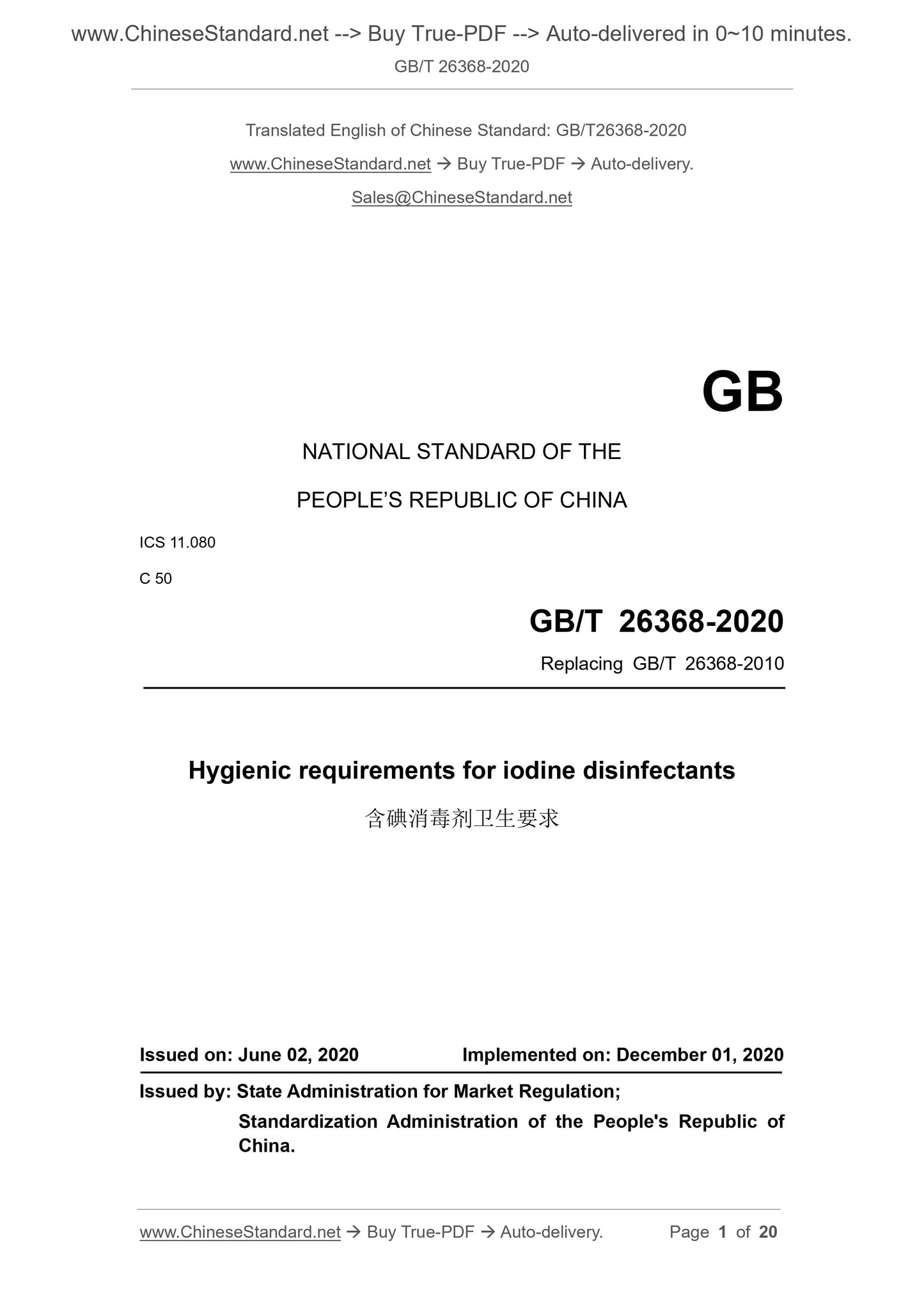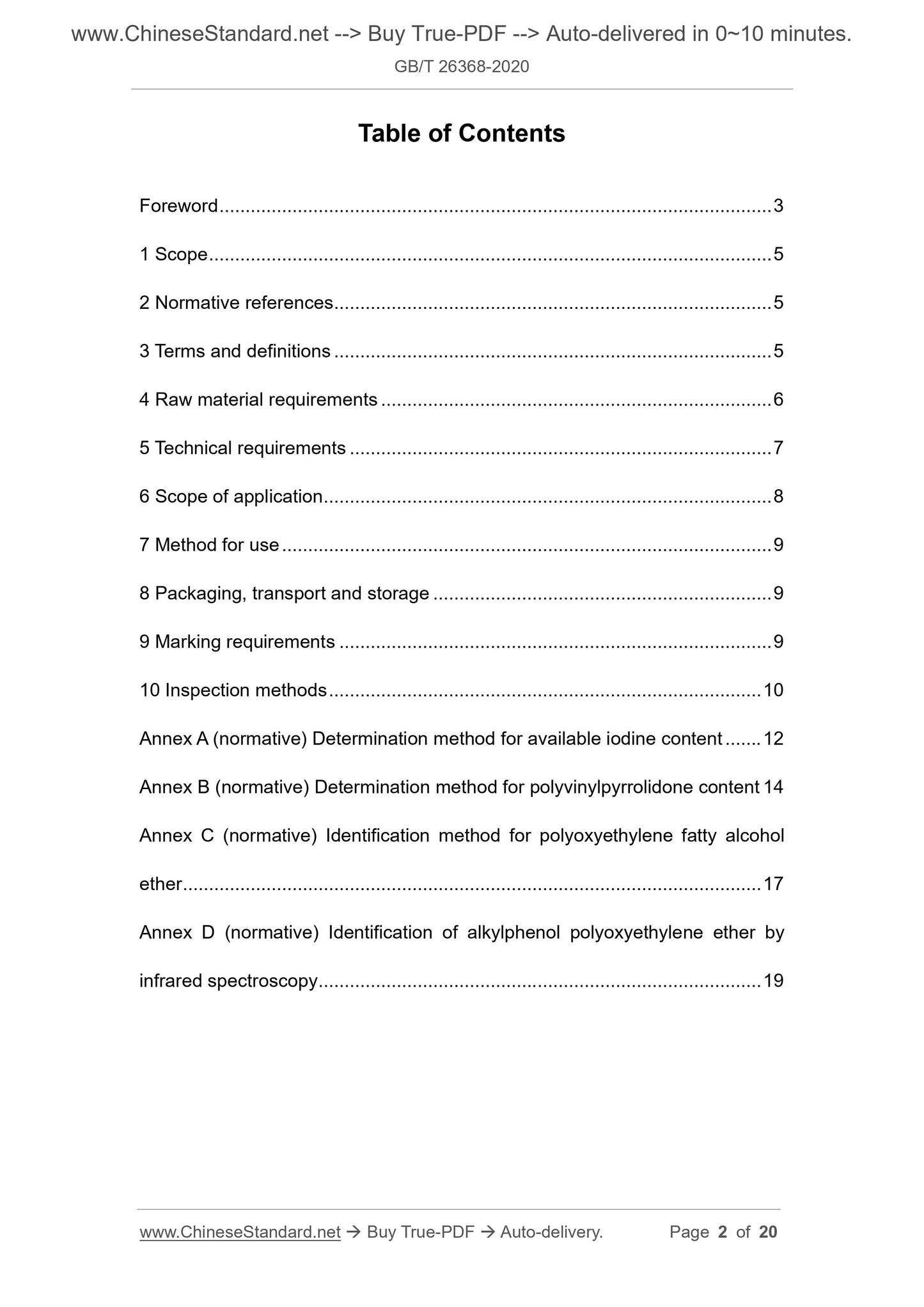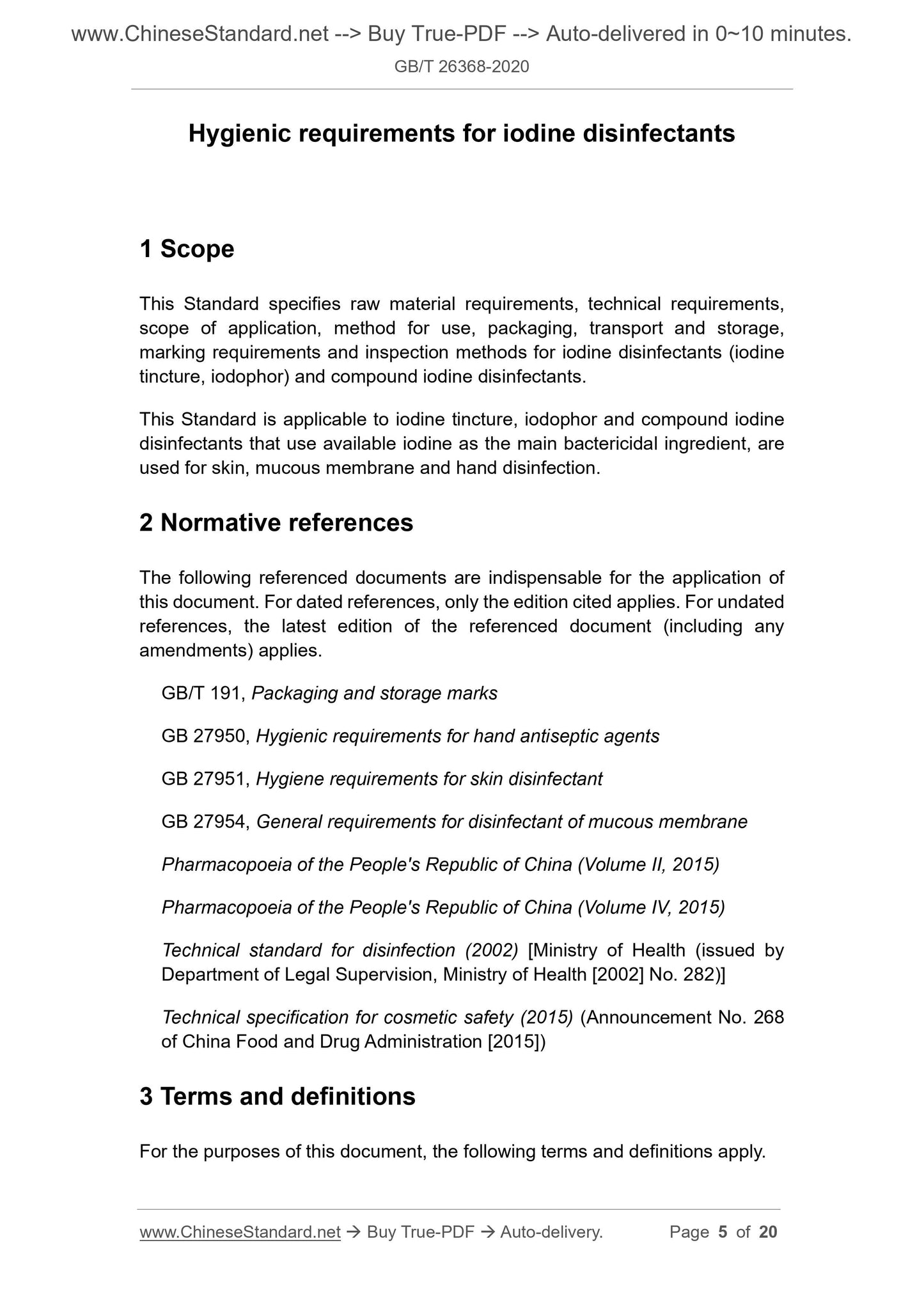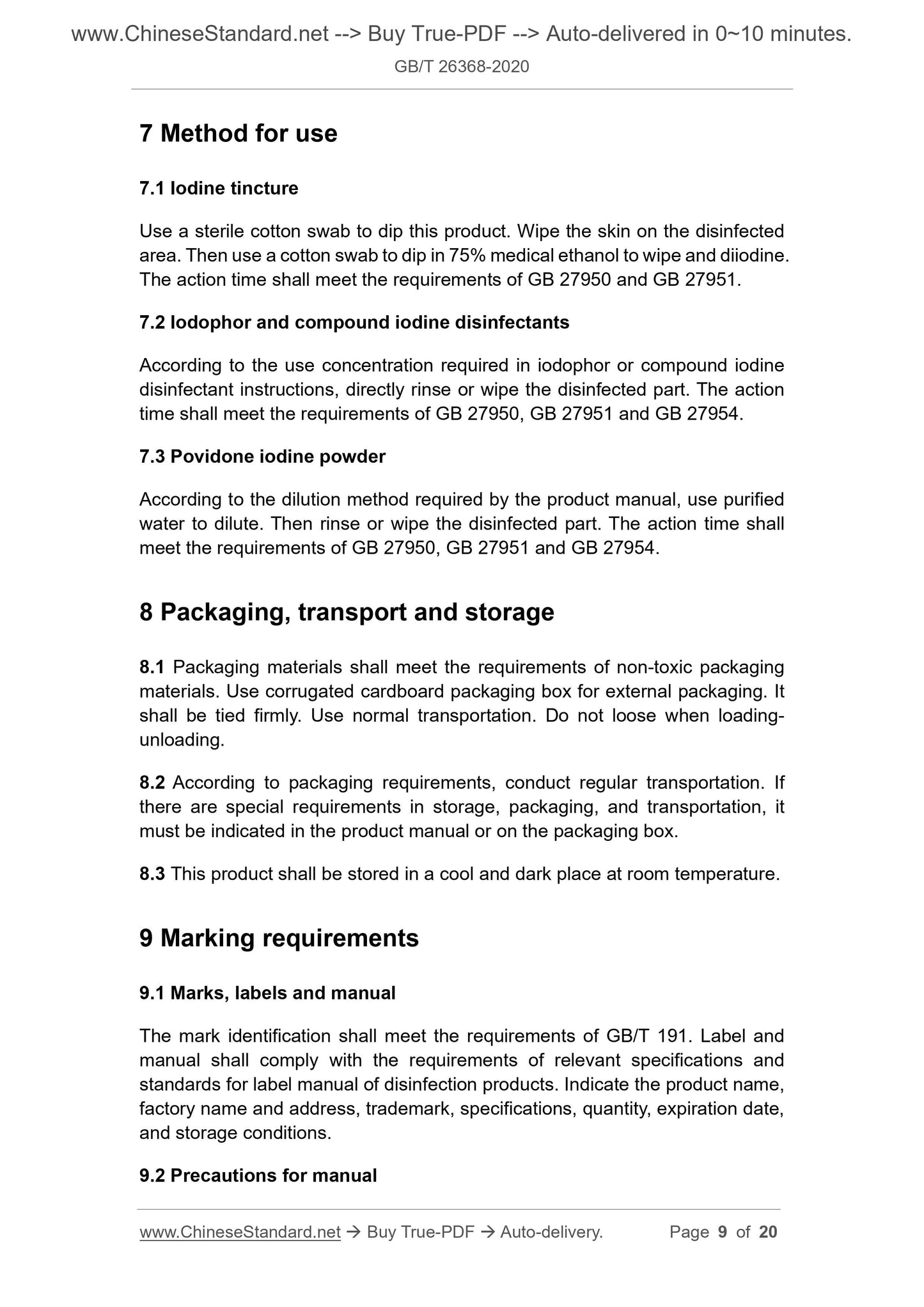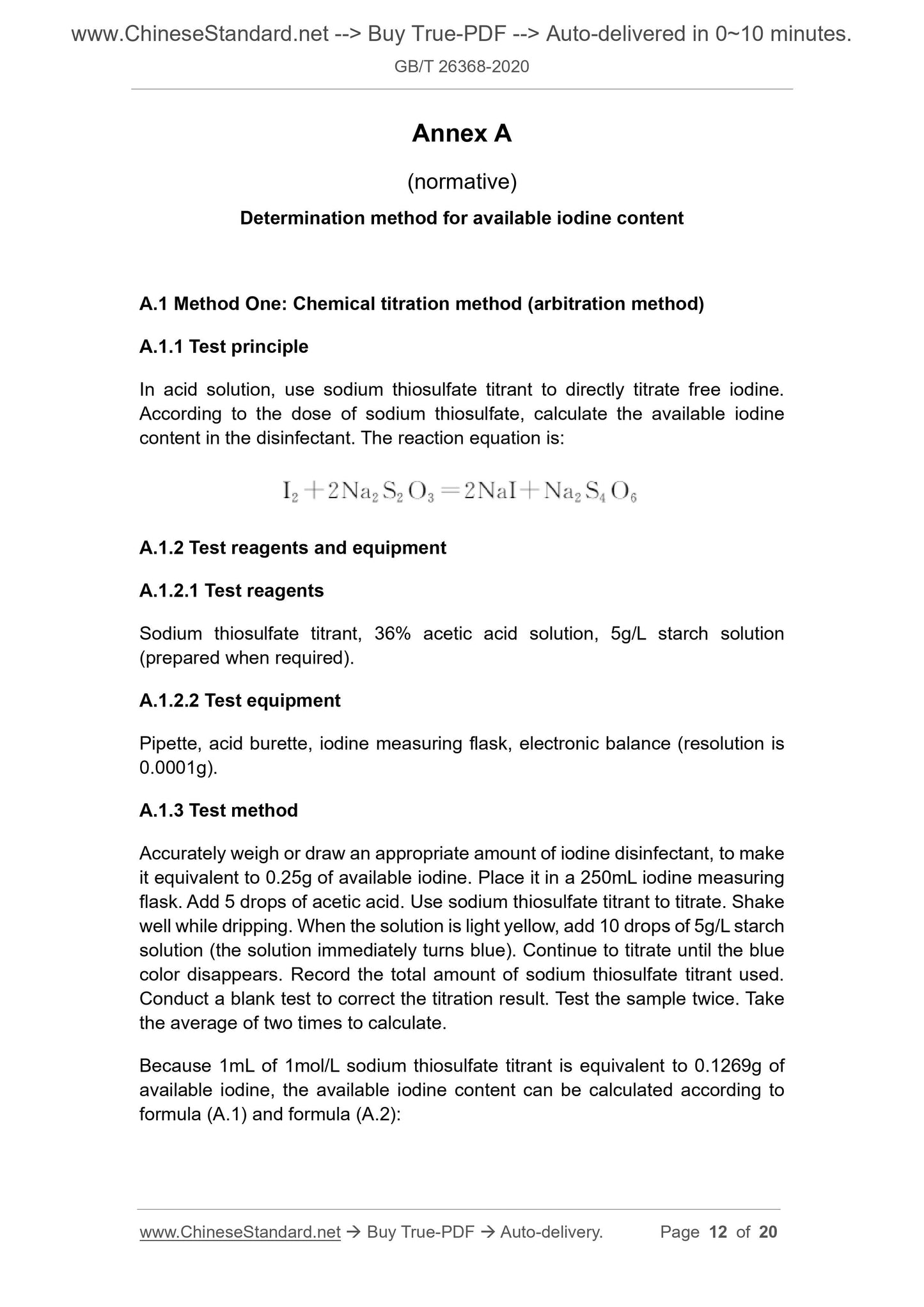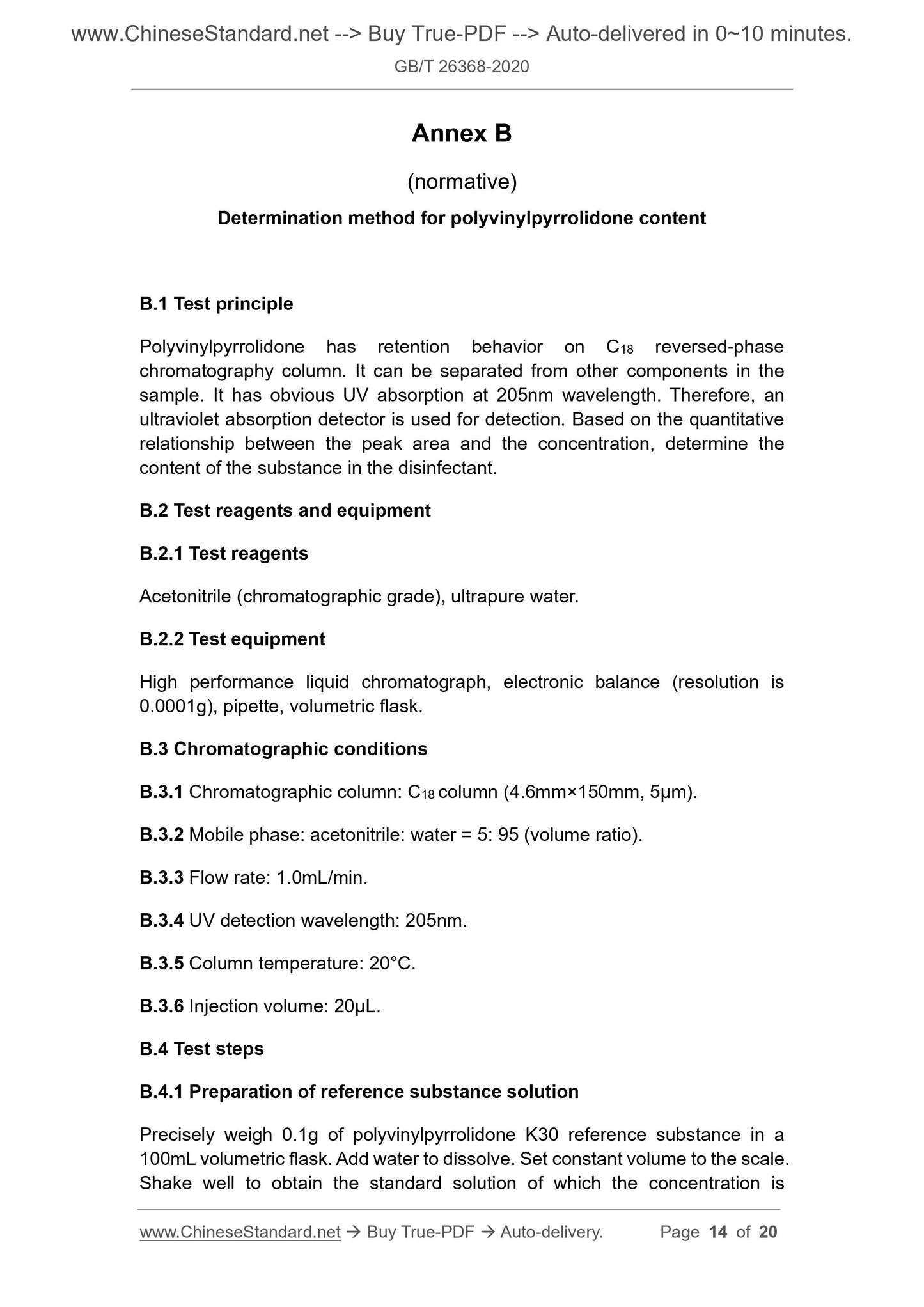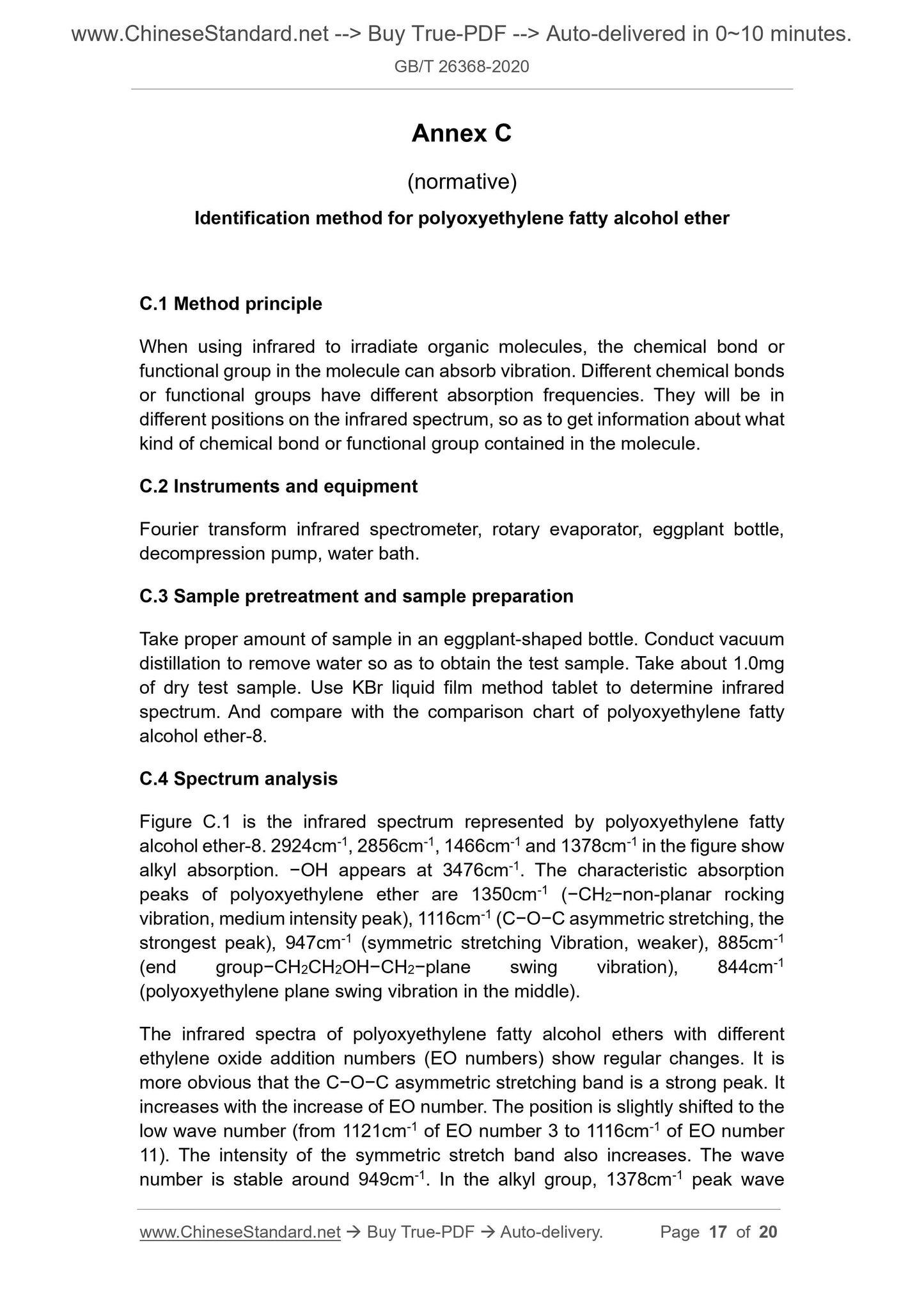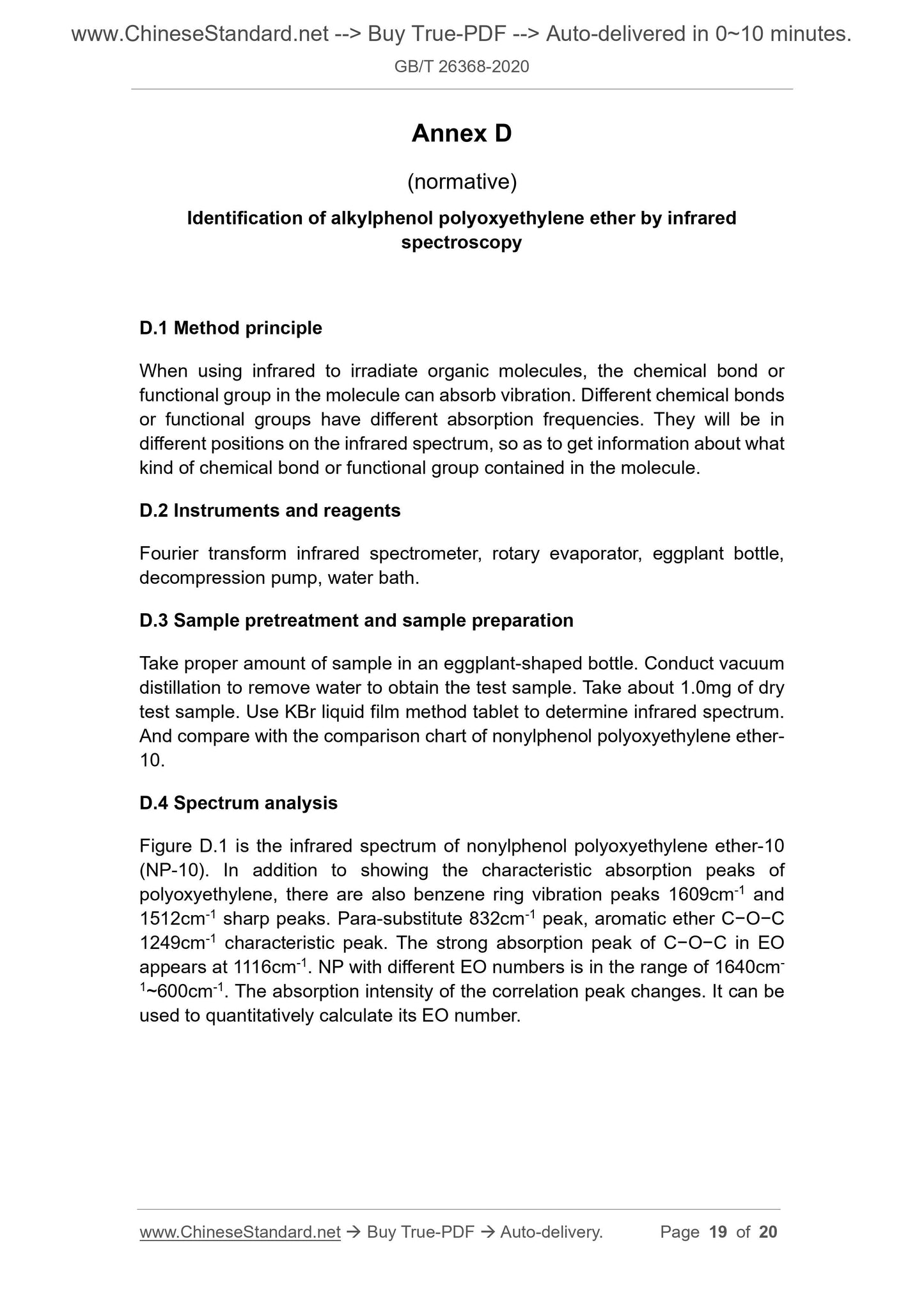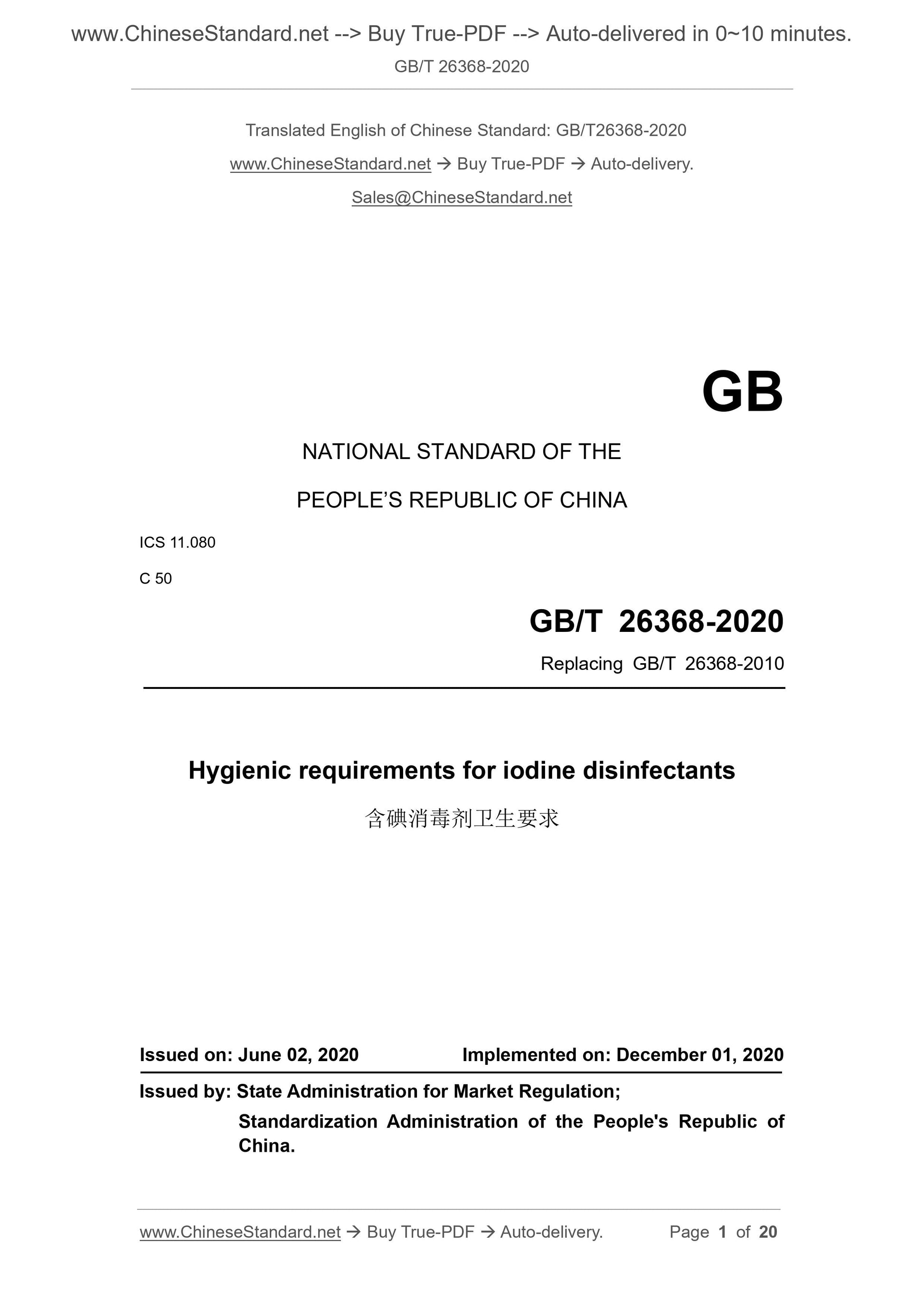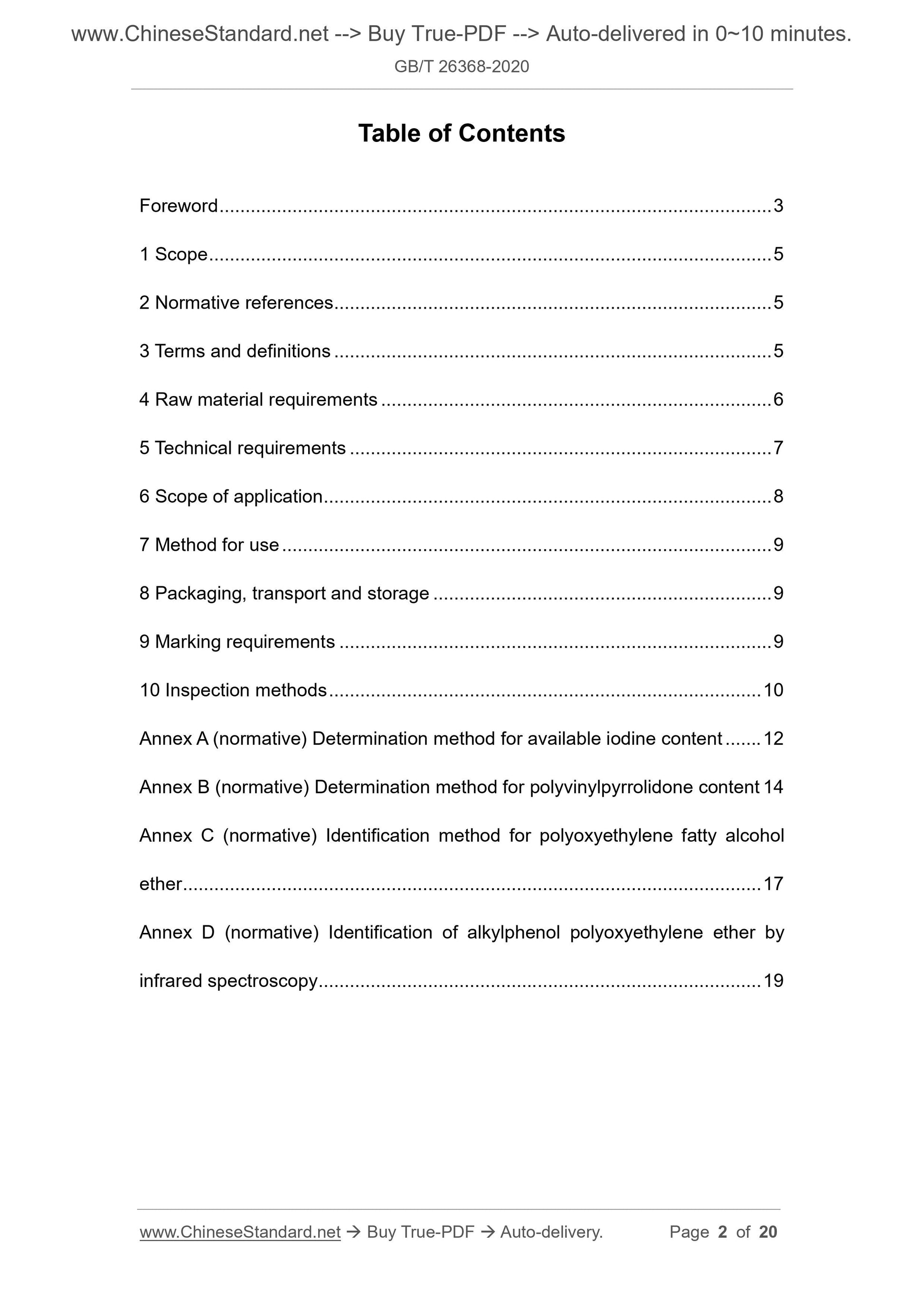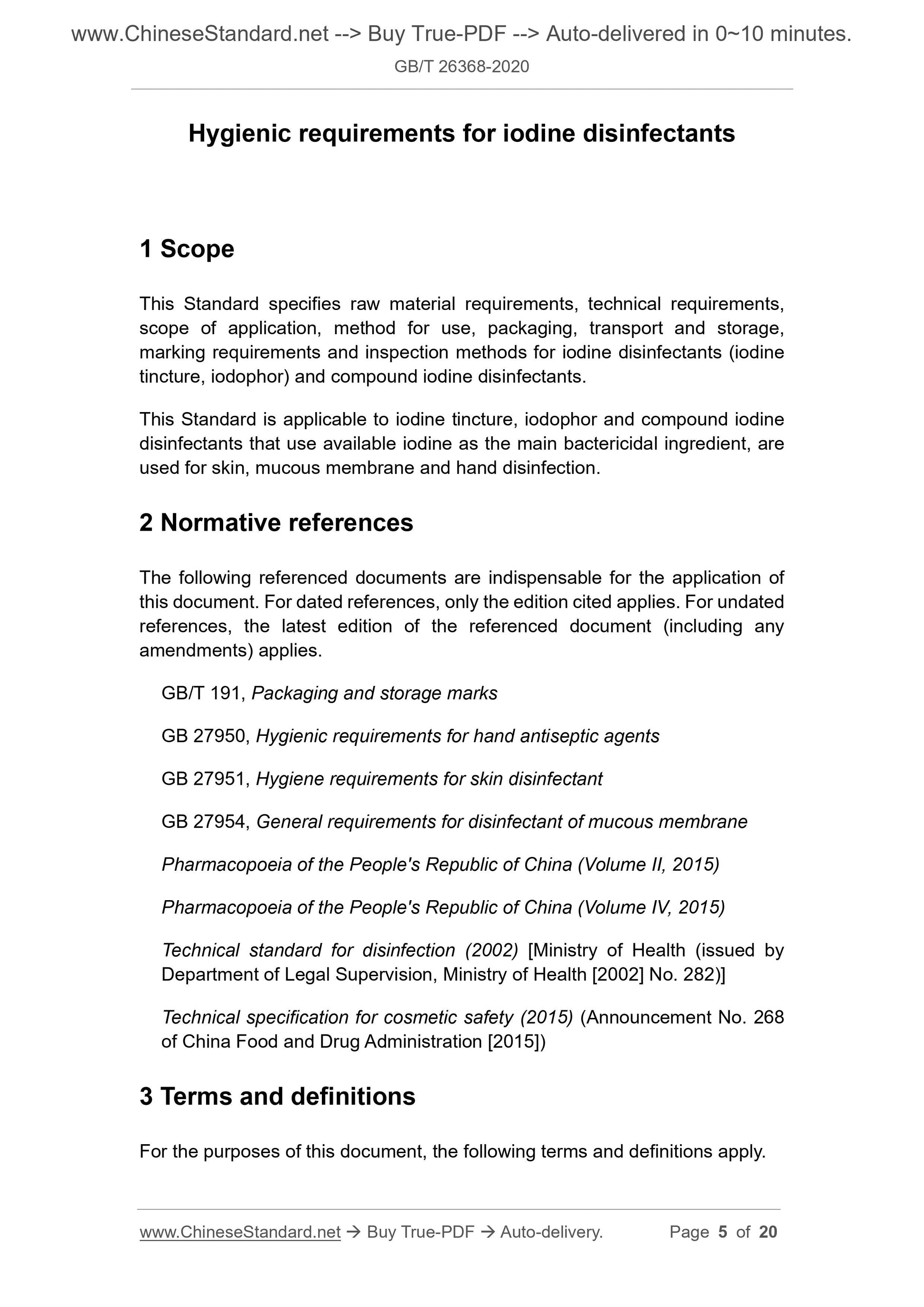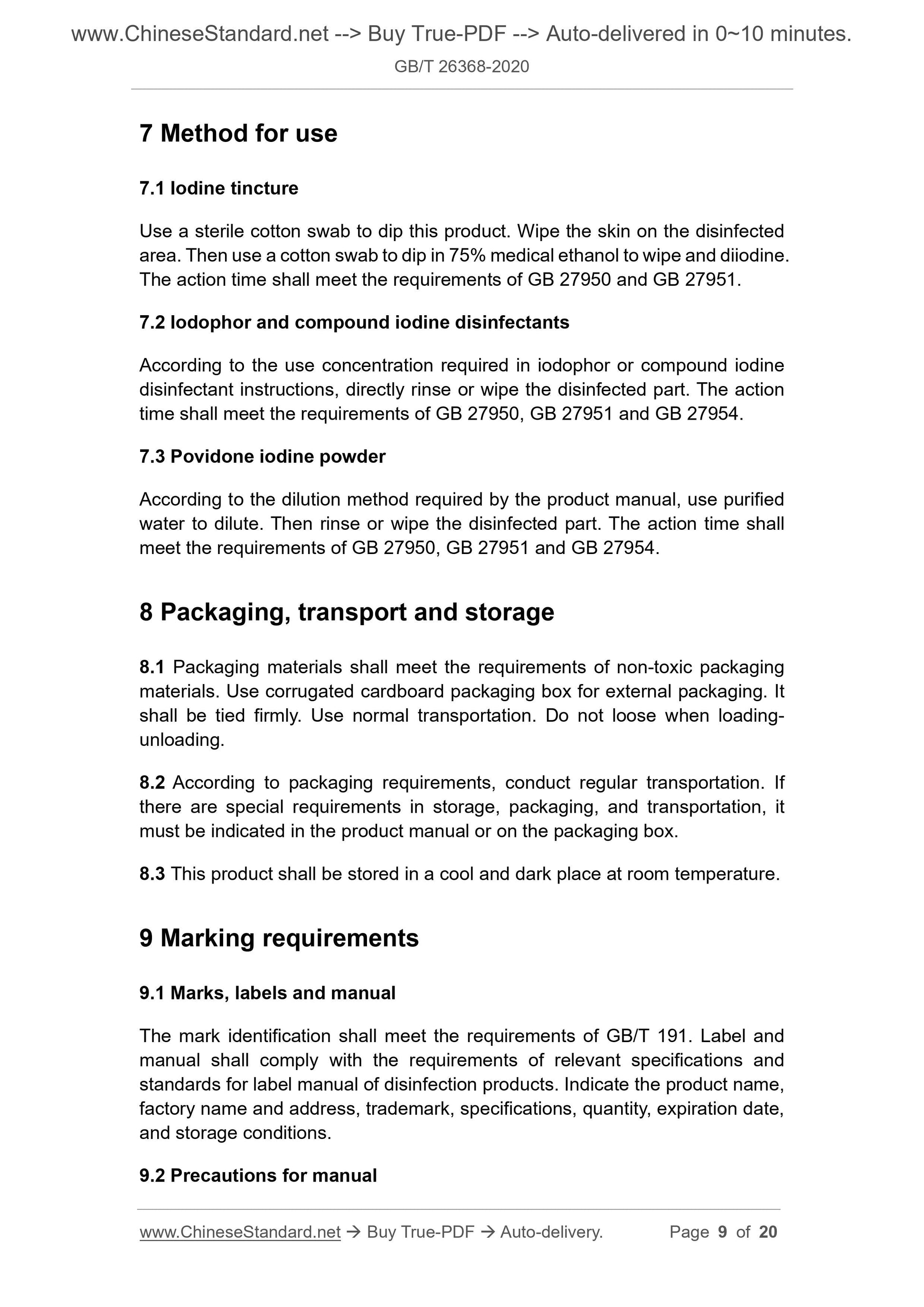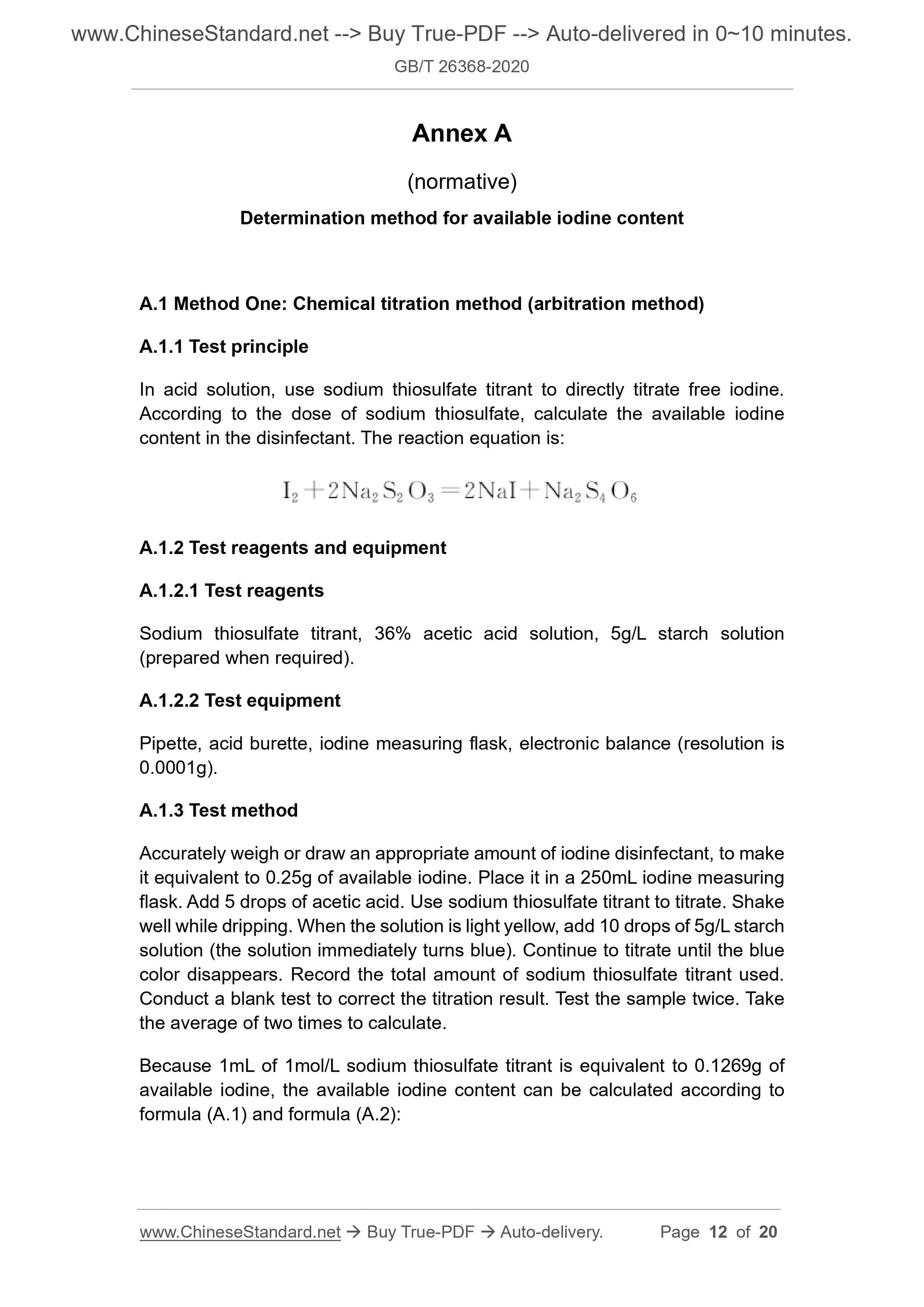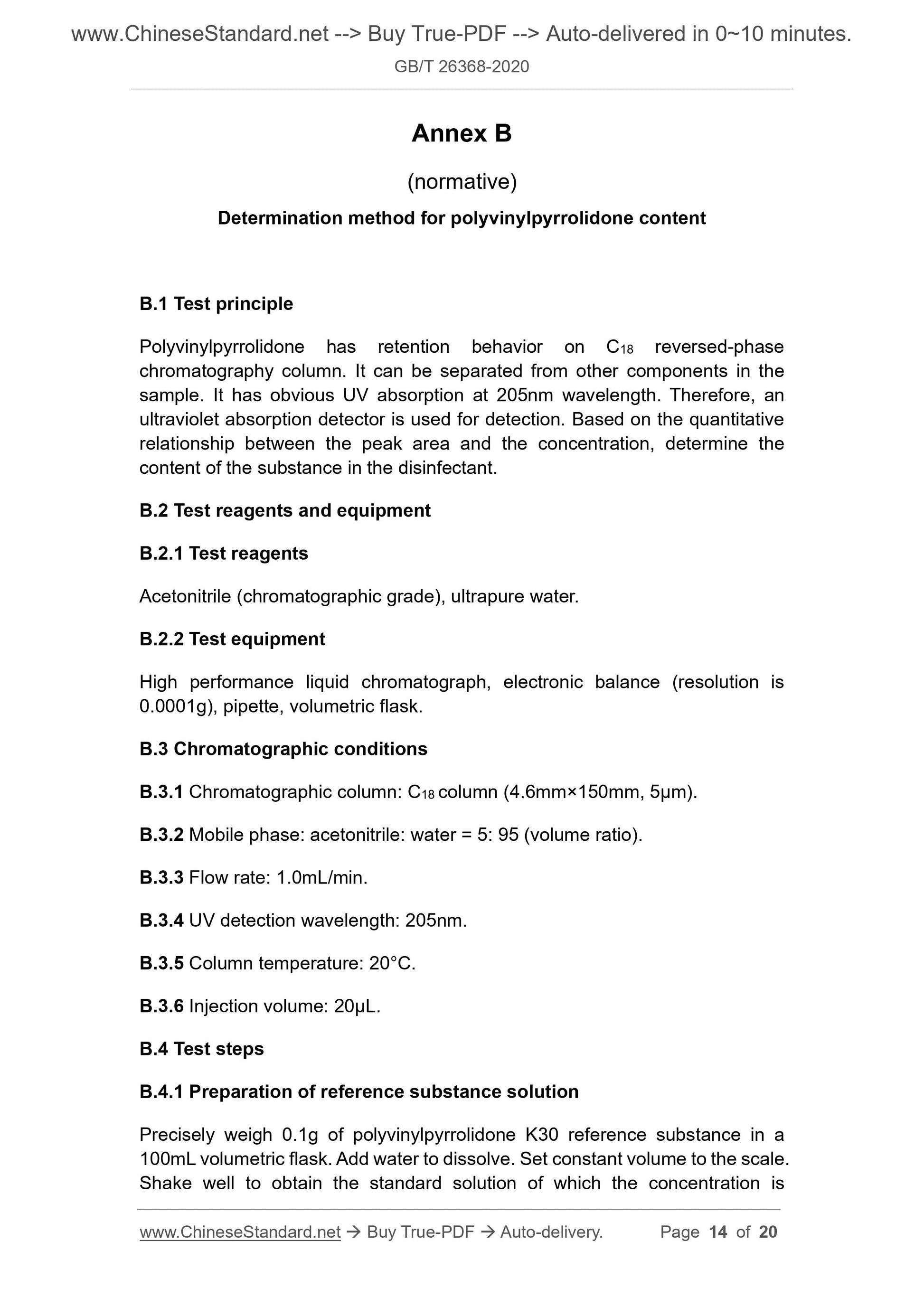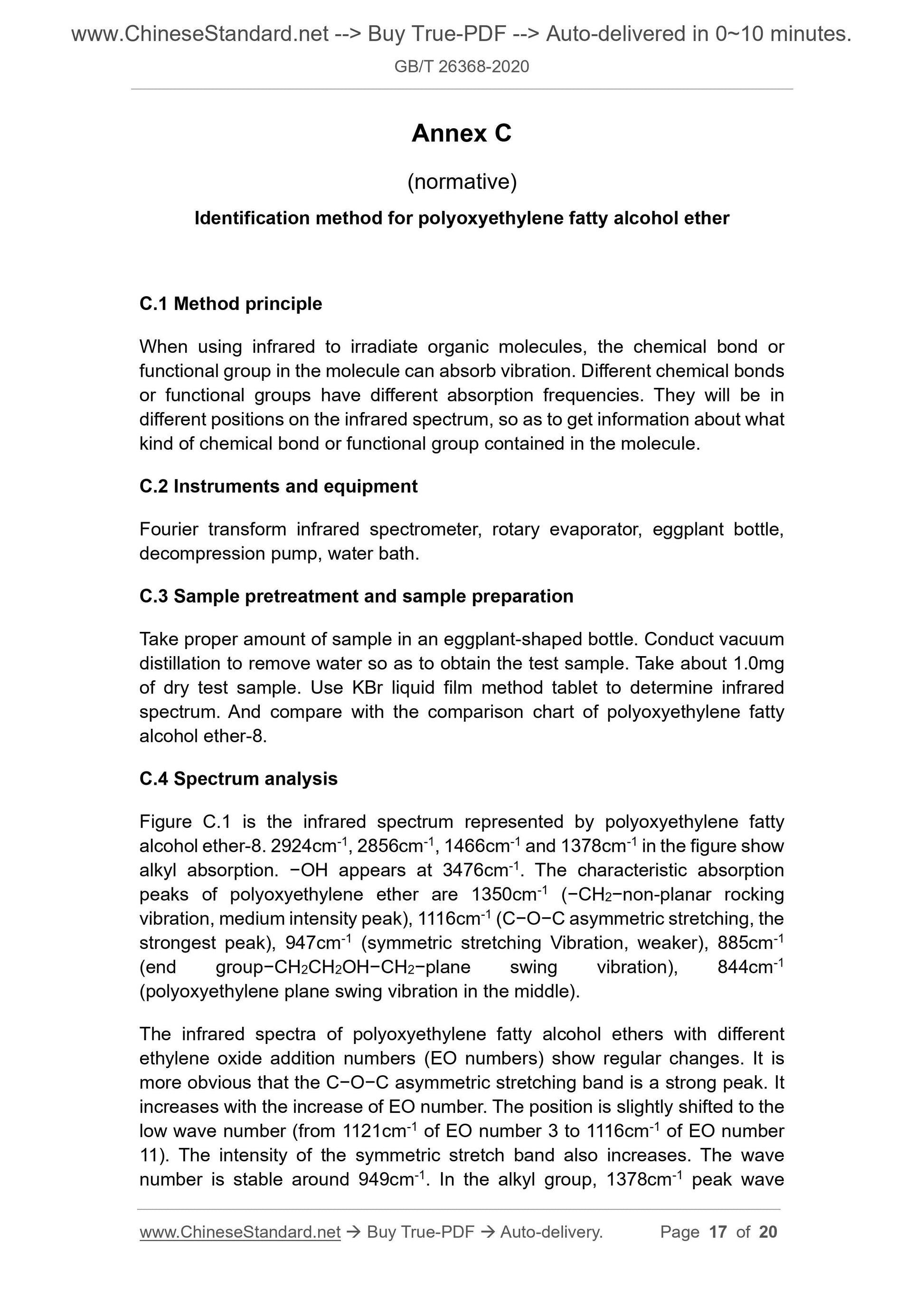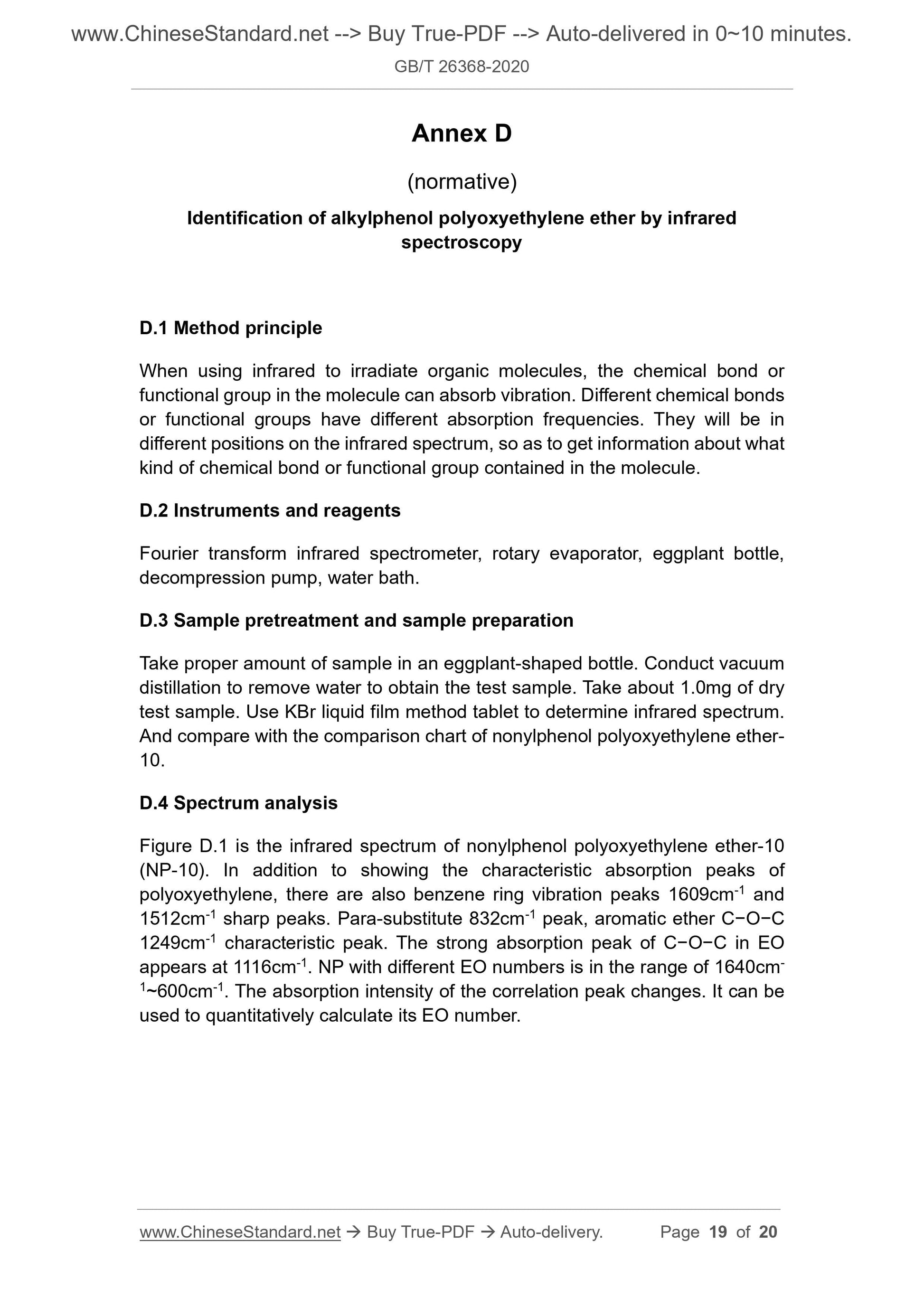1
/
of
8
PayPal, credit cards. Download editable-PDF and invoice in 1 second!
GB/T 26368-2020 English PDF (GBT26368-2020)
GB/T 26368-2020 English PDF (GBT26368-2020)
Regular price
$220.00 USD
Regular price
Sale price
$220.00 USD
Unit price
/
per
Shipping calculated at checkout.
Couldn't load pickup availability
Delivery: 3 seconds. Download true-PDF + Invoice.
Get QUOTATION in 1-minute: Click GB/T 26368-2020
Historical versions: GB/T 26368-2020
Preview True-PDF (Reload/Scroll if blank)
GB/T 26368-2020: Hygienic requirements for iodine disinfectants
GB/T 26368-2020
GB
NATIONAL STANDARD OF THE
PEOPLE’S REPUBLIC OF CHINA
ICS 11.080
C 50
Replacing GB/T 26368-2010
Hygienic requirements for iodine disinfectants
ISSUED ON: JUNE 02, 2020
IMPLEMENTED ON: DECEMBER 01, 2020
Issued by: State Administration for Market Regulation;
Standardization Administration of the People's Republic of
China.
Table of Contents
Foreword ... 3
1 Scope ... 5
2 Normative references ... 5
3 Terms and definitions ... 5
4 Raw material requirements ... 6
5 Technical requirements ... 7
6 Scope of application ... 8
7 Method for use ... 9
8 Packaging, transport and storage ... 9
9 Marking requirements ... 9
10 Inspection methods ... 10
Annex A (normative) Determination method for available iodine content ... 12
Annex B (normative) Determination method for polyvinylpyrrolidone content 14
Annex C (normative) Identification method for polyoxyethylene fatty alcohol
ether ... 17
Annex D (normative) Identification of alkylphenol polyoxyethylene ether by
infrared spectroscopy ... 19
Hygienic requirements for iodine disinfectants
1 Scope
This Standard specifies raw material requirements, technical requirements,
scope of application, method for use, packaging, transport and storage,
marking requirements and inspection methods for iodine disinfectants (iodine
tincture, iodophor) and compound iodine disinfectants.
This Standard is applicable to iodine tincture, iodophor and compound iodine
disinfectants that use available iodine as the main bactericidal ingredient, are
used for skin, mucous membrane and hand disinfection.
2 Normative references
The following referenced documents are indispensable for the application of
this document. For dated references, only the edition cited applies. For undated
references, the latest edition of the referenced document (including any
amendments) applies.
GB/T 191, Packaging and storage marks
GB 27950, Hygienic requirements for hand antiseptic agents
GB 27951, Hygiene requirements for skin disinfectant
GB 27954, General requirements for disinfectant of mucous membrane
Pharmacopoeia of the People's Republic of China (Volume II, 2015)
Pharmacopoeia of the People's Republic of China (Volume IV, 2015)
Technical standard for disinfection (2002) [Ministry of Health (issued by
Department of Legal Supervision, Ministry of Health [2002] No. 282)]
Technical specification for cosmetic safety (2015) (Announcement No. 268
of China Food and Drug Administration [2015])
3 Terms and definitions
For the purposes of this document, the following terms and definitions apply.
7 Method for use
7.1 Iodine tincture
Use a sterile cotton swab to dip this product. Wipe the skin on the disinfected
area. Then use a cotton swab to dip in 75% medical ethanol to wipe and diiodine.
The action time shall meet the requirements of GB 27950 and GB 27951.
7.2 Iodophor and compound iodine disinfectants
According to the use concentration required in iodophor or compound iodine
disinfectant instructions, directly rinse or wipe the disinfected part. The action
time shall meet the requirements of GB 27950, GB 27951 and GB 27954.
7.3 Povidone iodine powder
According to the dilution method required by the product manual, use purified
water to dilute. Then rinse or wipe the disinfected part. The action time shall
meet the requirements of GB 27950, GB 27951 and GB 27954.
8 Packaging, transport and storage
8.1 Packaging materials shall meet the requirements of non-toxic packaging
materials. Use corrugated cardboard packaging box for external packaging. It
shall be tied firmly. Use normal transportation. Do not loose when loading-
unloading.
8.2 According to packaging requirements, conduct regular transportation. If
there are special requirements in storage, packaging, and transportation, it
must be indicated in the product manual or on the packaging box.
8.3 This product shall be stored in a cool and dark place at room temperature.
9 Marking requirements
9.1 Marks, labels and manual
The mark identification shall meet the requirements of GB/T 191. Label and
manual shall comply with the requirements of relevant specifications and
standards for label manual of disinfection products. Indicate the product name,
factory name and address, trademark, specifications, quantity, expiration date,
and storage conditions.
9.2 Precautions for manual
Annex A
(normative)
Determination method for available iodine content
A.1 Method One: Chemical titration method (arbitration method)
A.1.1 Test principle
In acid solution, use sodium thiosulfate titrant to directly titrate free iodine.
According to the dose of sodium thiosulfate, calculate the available iodine
content in the disinfectant. The reaction equation is:
A.1.2 Test reagents and equipment
A.1.2.1 Test reagents
Sodium thiosulfate titrant, 36% acetic acid solution, 5g/L starch solution
(prepared when required).
A.1.2.2 Test equipment
Pipette, acid burette, iodine measuring flask, electronic balance (resolution is
0.0001g).
A.1.3 Test method
Accurately weigh or draw an appropriate amount of iodine disinfectant, to make
it equivalent to 0.25g of available iodine. Place it in a 250mL iodine measuring
flask. Add 5 drops of acetic acid. Use sodium thiosulfate titrant to titrate. Shake
well while dripping. When the solution is light yellow, add 10 drops of 5g/L starch
solution (the solution immediately turns blue). Continue to titrate until the blue
color disappears. Record the total amount of sodium thiosulfate titrant used.
Conduct a blank test to correct the titration result. Test the sample twice. Take
the average of two times to calculate.
Because 1mL of 1mol/L sodium thiosulfate titrant is equivalent to 0.1269g of
available iodine, the available iodine content can be calculated according to
formula (A.1) and formula (A.2):
Annex B
(normative)
Determination method for polyvinylpyrrolidone content
B.1 Test principle
Polyvinylpyrrolidone has retention behavior on C18 reversed-phase
chromatography column. It can be separated from other components in the
sample. It has obvious UV absorption at 205nm wavelength. Therefore, an
ultraviolet absorption detector is used for detection. Based on the quantitative
relationship between the peak area and the concentration, determine the
content of the substance in the disinfectant.
B.2 Test reagents and equipment
B.2.1 Test reagents
Acetonitrile (chromatographic grade), ultrapure water.
B.2.2 Test equipment
High performance liquid chromatograph, electronic balance (resolution is
0.0001g), pipette, volumetric flask.
B.3 Chromatographic conditions
B.3.1 Chromatographic column: C18 column (4.6mm×150mm, 5μm).
B.3.2 Mobile phase: acetonitrile: water = 5: 95 (volume ratio).
B.3.3 Flow rate: 1.0mL/min.
B.3.4 UV detection wavelength: 205nm.
B.3.5 Column temperature: 20°C.
B.3.6 Injection volume: 20μL.
B.4 Test steps
B.4.1 Preparation of reference substance solution
Precisely weigh 0.1g of polyvinylpyrrolidone K30 reference substance in a
100mL volumetric flask. Add water to dissolve. Set constant volume to the scale.
Shake well to obtain the standard solution of which the concentration is
Annex C
(normative)
Identification method for polyoxyethylene fatty alcohol ether
C.1 Method principle
When using infrared to irradiate organic molecules, the chemical bond or...
Get QUOTATION in 1-minute: Click GB/T 26368-2020
Historical versions: GB/T 26368-2020
Preview True-PDF (Reload/Scroll if blank)
GB/T 26368-2020: Hygienic requirements for iodine disinfectants
GB/T 26368-2020
GB
NATIONAL STANDARD OF THE
PEOPLE’S REPUBLIC OF CHINA
ICS 11.080
C 50
Replacing GB/T 26368-2010
Hygienic requirements for iodine disinfectants
ISSUED ON: JUNE 02, 2020
IMPLEMENTED ON: DECEMBER 01, 2020
Issued by: State Administration for Market Regulation;
Standardization Administration of the People's Republic of
China.
Table of Contents
Foreword ... 3
1 Scope ... 5
2 Normative references ... 5
3 Terms and definitions ... 5
4 Raw material requirements ... 6
5 Technical requirements ... 7
6 Scope of application ... 8
7 Method for use ... 9
8 Packaging, transport and storage ... 9
9 Marking requirements ... 9
10 Inspection methods ... 10
Annex A (normative) Determination method for available iodine content ... 12
Annex B (normative) Determination method for polyvinylpyrrolidone content 14
Annex C (normative) Identification method for polyoxyethylene fatty alcohol
ether ... 17
Annex D (normative) Identification of alkylphenol polyoxyethylene ether by
infrared spectroscopy ... 19
Hygienic requirements for iodine disinfectants
1 Scope
This Standard specifies raw material requirements, technical requirements,
scope of application, method for use, packaging, transport and storage,
marking requirements and inspection methods for iodine disinfectants (iodine
tincture, iodophor) and compound iodine disinfectants.
This Standard is applicable to iodine tincture, iodophor and compound iodine
disinfectants that use available iodine as the main bactericidal ingredient, are
used for skin, mucous membrane and hand disinfection.
2 Normative references
The following referenced documents are indispensable for the application of
this document. For dated references, only the edition cited applies. For undated
references, the latest edition of the referenced document (including any
amendments) applies.
GB/T 191, Packaging and storage marks
GB 27950, Hygienic requirements for hand antiseptic agents
GB 27951, Hygiene requirements for skin disinfectant
GB 27954, General requirements for disinfectant of mucous membrane
Pharmacopoeia of the People's Republic of China (Volume II, 2015)
Pharmacopoeia of the People's Republic of China (Volume IV, 2015)
Technical standard for disinfection (2002) [Ministry of Health (issued by
Department of Legal Supervision, Ministry of Health [2002] No. 282)]
Technical specification for cosmetic safety (2015) (Announcement No. 268
of China Food and Drug Administration [2015])
3 Terms and definitions
For the purposes of this document, the following terms and definitions apply.
7 Method for use
7.1 Iodine tincture
Use a sterile cotton swab to dip this product. Wipe the skin on the disinfected
area. Then use a cotton swab to dip in 75% medical ethanol to wipe and diiodine.
The action time shall meet the requirements of GB 27950 and GB 27951.
7.2 Iodophor and compound iodine disinfectants
According to the use concentration required in iodophor or compound iodine
disinfectant instructions, directly rinse or wipe the disinfected part. The action
time shall meet the requirements of GB 27950, GB 27951 and GB 27954.
7.3 Povidone iodine powder
According to the dilution method required by the product manual, use purified
water to dilute. Then rinse or wipe the disinfected part. The action time shall
meet the requirements of GB 27950, GB 27951 and GB 27954.
8 Packaging, transport and storage
8.1 Packaging materials shall meet the requirements of non-toxic packaging
materials. Use corrugated cardboard packaging box for external packaging. It
shall be tied firmly. Use normal transportation. Do not loose when loading-
unloading.
8.2 According to packaging requirements, conduct regular transportation. If
there are special requirements in storage, packaging, and transportation, it
must be indicated in the product manual or on the packaging box.
8.3 This product shall be stored in a cool and dark place at room temperature.
9 Marking requirements
9.1 Marks, labels and manual
The mark identification shall meet the requirements of GB/T 191. Label and
manual shall comply with the requirements of relevant specifications and
standards for label manual of disinfection products. Indicate the product name,
factory name and address, trademark, specifications, quantity, expiration date,
and storage conditions.
9.2 Precautions for manual
Annex A
(normative)
Determination method for available iodine content
A.1 Method One: Chemical titration method (arbitration method)
A.1.1 Test principle
In acid solution, use sodium thiosulfate titrant to directly titrate free iodine.
According to the dose of sodium thiosulfate, calculate the available iodine
content in the disinfectant. The reaction equation is:
A.1.2 Test reagents and equipment
A.1.2.1 Test reagents
Sodium thiosulfate titrant, 36% acetic acid solution, 5g/L starch solution
(prepared when required).
A.1.2.2 Test equipment
Pipette, acid burette, iodine measuring flask, electronic balance (resolution is
0.0001g).
A.1.3 Test method
Accurately weigh or draw an appropriate amount of iodine disinfectant, to make
it equivalent to 0.25g of available iodine. Place it in a 250mL iodine measuring
flask. Add 5 drops of acetic acid. Use sodium thiosulfate titrant to titrate. Shake
well while dripping. When the solution is light yellow, add 10 drops of 5g/L starch
solution (the solution immediately turns blue). Continue to titrate until the blue
color disappears. Record the total amount of sodium thiosulfate titrant used.
Conduct a blank test to correct the titration result. Test the sample twice. Take
the average of two times to calculate.
Because 1mL of 1mol/L sodium thiosulfate titrant is equivalent to 0.1269g of
available iodine, the available iodine content can be calculated according to
formula (A.1) and formula (A.2):
Annex B
(normative)
Determination method for polyvinylpyrrolidone content
B.1 Test principle
Polyvinylpyrrolidone has retention behavior on C18 reversed-phase
chromatography column. It can be separated from other components in the
sample. It has obvious UV absorption at 205nm wavelength. Therefore, an
ultraviolet absorption detector is used for detection. Based on the quantitative
relationship between the peak area and the concentration, determine the
content of the substance in the disinfectant.
B.2 Test reagents and equipment
B.2.1 Test reagents
Acetonitrile (chromatographic grade), ultrapure water.
B.2.2 Test equipment
High performance liquid chromatograph, electronic balance (resolution is
0.0001g), pipette, volumetric flask.
B.3 Chromatographic conditions
B.3.1 Chromatographic column: C18 column (4.6mm×150mm, 5μm).
B.3.2 Mobile phase: acetonitrile: water = 5: 95 (volume ratio).
B.3.3 Flow rate: 1.0mL/min.
B.3.4 UV detection wavelength: 205nm.
B.3.5 Column temperature: 20°C.
B.3.6 Injection volume: 20μL.
B.4 Test steps
B.4.1 Preparation of reference substance solution
Precisely weigh 0.1g of polyvinylpyrrolidone K30 reference substance in a
100mL volumetric flask. Add water to dissolve. Set constant volume to the scale.
Shake well to obtain the standard solution of which the concentration is
Annex C
(normative)
Identification method for polyoxyethylene fatty alcohol ether
C.1 Method principle
When using infrared to irradiate organic molecules, the chemical bond or...
Share
